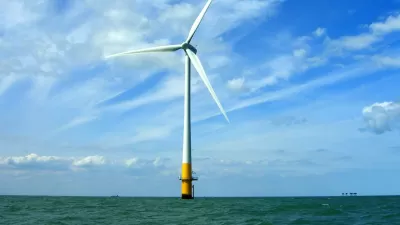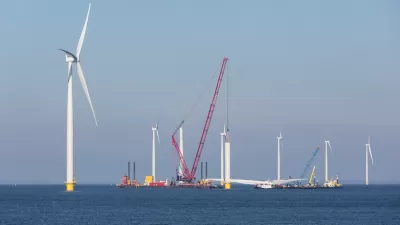The first commercial-scale offshore wind installation in the United States is powering roughly 70,000 homes in Long Island, New York.

The South Fork Wind Farm off the coast of Montauk, New York is the nation’s first commercial-scale offshore wind farm and a bright spot in a struggling industry that “offers tangible evidence that wind projects can work,” writes Pippa Stevens for CNBC News.
The project produces enough power for 70,000 homes annually, which it sells to the Long Island Power Authority. “Each turbine is connected to an offshore substation – the first of its kind built in the U.S. – which is connected to the local power grid in East Hampton, New York, via a 65-mile subsea and underground cable.”
The growth of the offshore wind industry has come in fits and starts, with interest rates and an uncertain, specialized supply chain driving up project costs and forcing companies to cancel some projects altogether. Because operators sign long-term contracts with power purchasers long in advance of construction, ballooning costs can make some projects financially unfeasible.
“The U.S. does have 58 gigawatts of capacity under development, according to American Clean Power, but some of those projects won’t come online for years, and there is no guarantee all of them will be built.” However, industry experts are optimistic that the sector is in a period of readjustment and will bounce back as components and skilled labor become more available.

Alabama: Trump Terminates Settlements for Black Communities Harmed By Raw Sewage
Trump deemed the landmark civil rights agreement “illegal DEI and environmental justice policy.”

Planetizen Federal Action Tracker
A weekly monitor of how Trump’s orders and actions are impacting planners and planning in America.

Why Should We Subsidize Public Transportation?
Many public transit agencies face financial stress due to rising costs, declining fare revenue, and declining subsidies. Transit advocates must provide a strong business case for increasing public transit funding.

Understanding Road Diets
An explainer from Momentum highlights the advantages of reducing vehicle lanes in favor of more bike, transit, and pedestrian infrastructure.

New California Law Regulates Warehouse Pollution
A new law tightens building and emissions regulations for large distribution warehouses to mitigate air pollution and traffic in surrounding communities.

Phoenix Announces Opening Date for Light Rail Extension
The South Central extension will connect South Phoenix to downtown and other major hubs starting on June 7.
Urban Design for Planners 1: Software Tools
This six-course series explores essential urban design concepts using open source software and equips planners with the tools they need to participate fully in the urban design process.
Planning for Universal Design
Learn the tools for implementing Universal Design in planning regulations.
Caltrans
Smith Gee Studio
Institute for Housing and Urban Development Studies (IHS)
City of Grandview
Harvard GSD Executive Education
Toledo-Lucas County Plan Commissions
Salt Lake City
NYU Wagner Graduate School of Public Service





























